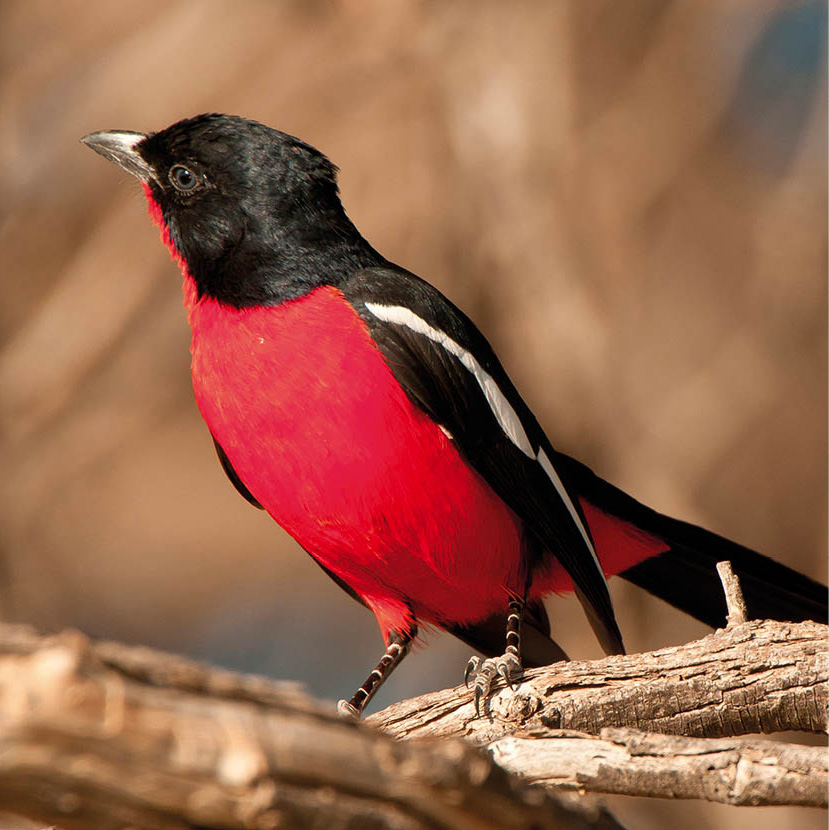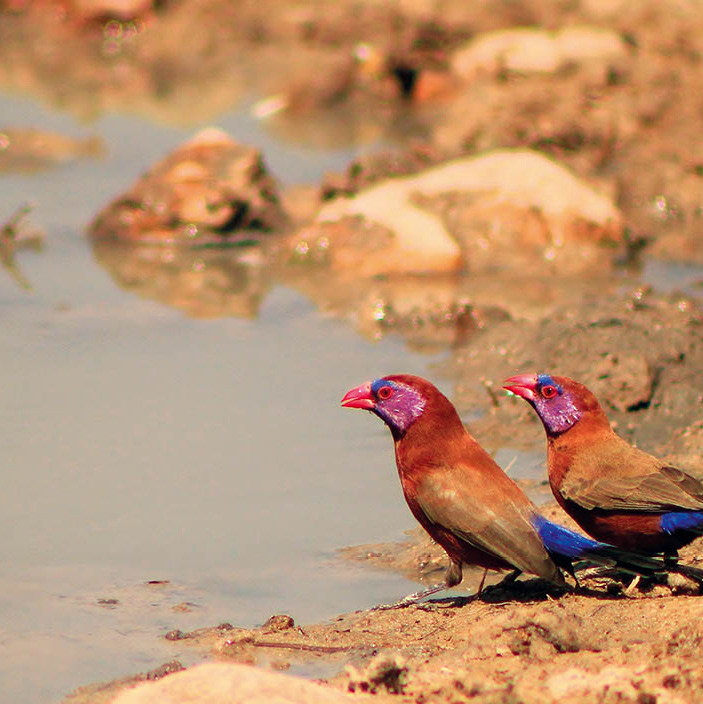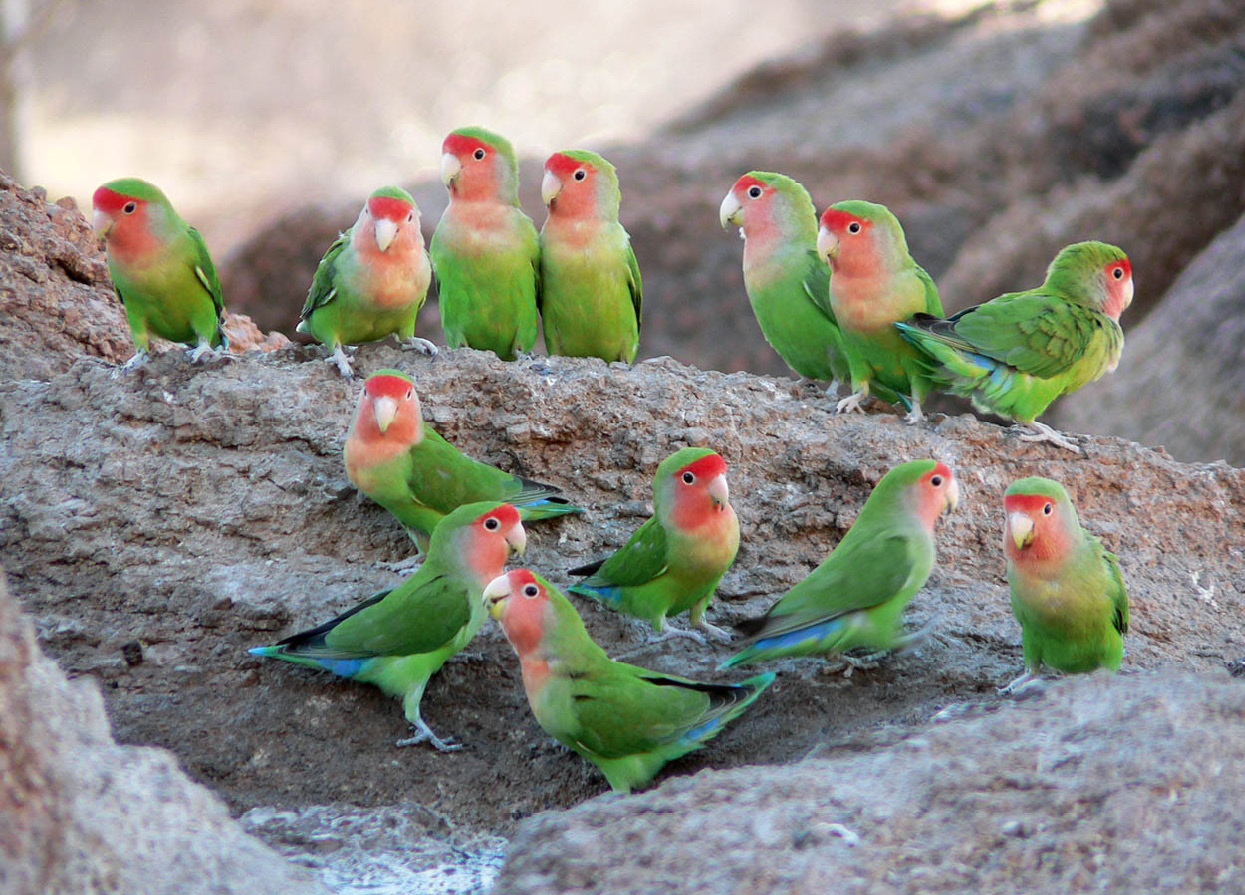The diversity of habitats in Namibia is reflected in the number of birds found there. A total of 706 bird species have now been recorded in the country, of which one, the dune lark, is endemic (found nowhere else in the world) and 14 are near endemic (more than 95 percent of their range lies within Namibia). More than 500 species breed locally, the remainder being migrants.

The distinctive bateleur eagle.
123RF
Coastal habitats include rocky and sandy shores, lagoons and saltworks (the latter are found in all of Namibia’s major coastal towns, and have a pronounced effect on the local bird populations). These give rise to some remarkable birds, from the great white pelican (Pelecanus onocrotalus), so characteristic of the coastline round here, to the greater and lesser flamingos (Phoenicopterus ruber and Phoeniconaias minor) which occur in very great numbers along these shores, and whose sonorous honking can be heard all night when the tides are right for night-time foraging.
A distinctive bird of prey found in the semi-desert is the bateleur. It has the shortest tail of any eagle, so rocks from side to side as it flies, hence the name: bateleur is French for an acrobat of sorts.
Birdwatchers in these coastal regions can also expect to see large skeins of cormorants (four species), accompanied by Cape gannets (Morus capensis) flying offshore. Closer inshore, enthusiasts are quite likely to encounter several species of terns and gulls, the most common of which are the kelp gull (Larus dominicanus) and Hartlaub’s gull (Larus hartlaubii).

The dramatic plumage of the crimson-breasted shrike.
Dreamstime
One of the most interesting birds of the Namib coast is the tiny Damara tern (Sterna balaenarum), whose world population numbers only about 7,000 individuals. They breed along the Namib coast in summer and migrate northwards to Nigeria in autumn. Their nest consists of a shallow scraper on the gravel plains of the desert, usually a couple of kilometres (1 mile) inland. Only one egg is laid; shortly after hatching, the chick leaves the nest and wanders about, probably to avoid predators such as black-backed jackals which are common in the region. Parents and offspring keep in touch through contact calls. The main threats to the survival of the Damara tern are habitat loss and the large number of thoughtless off-road drivers who crush the eggs.
African penguins (Spheniscus demersus) are occasionally seen near the shore, but these delightful birds prefer to forage out to sea, breeding on islands off the coast. Their call is a loud, donkey-like bray.

White pelicans are numerous on the coast.
Ute von Ludwiger/Namibia Tourism Board
Desert habitats
The gravel plains north of the Kuiseb River and the sand dune complex to the south support a small but distinctive bird population. The most obvious of these is the ostrich (Struthio camelus), the world’s largest bird, which occurs in large numbers in even the most barren habitats, and may often be spotted in the distance, running elegantly through the desert mirage. They are usually seen in pairs or groups, sometimes with large crêches of young birds.
Equally memorable, though much smaller, is the Namaqua sandgrouse (Pterocles namaqua), huge flocks of which can be seen making spectacular daily visits to desert waterholes. This little bird is related to the pigeon, but it has a longer tail and lovely sand-speckled markings.
Drinks Carrier
The Namaqua sandgrouse is well adapted to its arid environment, having evolved a method of collecting water for its young and transporting it over long distances. (There is precious little liquid to be obtained from the bird’s usual diet of dry seeds.)
The adult sandgrouse’s breast feathers are specially modified to absorb and hold moisture. The bird visits a waterhole in the early morning and completely immerses its breast in water, then flies back to the nest site – up to 50km (30 miles) away – laden with precious liquid, which the chicks then release by nibbling at the parent’s breast feathers.
Other birds found in these areas include the stately bustards and korhaans. Frequently seen in Etosha is the kori bustard (Ardeotis kori), reputedly the largest flying bird in the world – although it is reluctant to take to the air unless threatened. The male has a dramatic display in the breeding season. It inflates its throat to fan out white neck feathers, arches its tail up along its back and emits a deep “oom-oom-oom” call.
Rüppell’s korhaan (Eupodotis rueppellii), found almost exclusively in the Namib desert, is nicknamed the desert frog because of its strange croaking call.
A number of raptors including the lovely little red-necked falcon (Falco chicquera) turn up in this area. So too do several species of larks, buntings and chats which are of particular interest to keen birdwatchers since many of the creatures are extremely specialised and limited in their distribution.

The martial eagle (Polemaetus bellicosus), one of the largest birds of prey.
Dreamstime
The semi-desert escarpment
An important area for near-endemics in Namibia is the transition zone between the desert and the arid savannahs. These include the Damara hornbill (Tockus damarensis), a plain-faced form of the charismatic red-billed hornbill that was recently elevated from sub-specific status to be listed as a full species.
Other birds found here include a small green and pink-marked member of the parrot family much loved by cage bird enthusiasts, the rosy-collared or rosy-faced lovebird (Agapornis roseicollis), which is generally found in small and quite noisy groups and, because it needs to drink regularly, is never too far from water.
The African skimmer gets its name from its fishing technique – flying low with its bottom jaw dipped just below the water. If it sees a fish, the bird snaps its bill closed, neatly trapping its prey.
Also look out for that striking, self-assured little harlequin, the white-tailed shrike (Lanioturdus torquatus), and the rockrunner or Damara Rock-jumper (Achaetops pycnopygius), a small brown bird with an enchanting liquid call, which scuttles around rocky outcrops like a mouse, darting for cover into grass. Other species you may see here include Hartlaub’s francolin (Pternistis hartlaubi), often seen in small groups scurrying over rocks, Bradfield’s swift (Apus bradfieldi), the cackling violet wood-hoopoe (Phoeniculus damarensis), and the tiny Herero chat (Namibornis herero).

Violet-eared waxbills (Uraeginthus granatinus).
Dreamstime
The arid savannah
The southern Kalahari, the central highlands and the north-central regions reaching as far north as the Etosha National Park all comprise a number of acacia-dominated vegetation types. One of the most striking species of birds found in places in these regions is the sociable weaver (Philetairus socius). This species is noticeable mainly for its communal nests, which are enormous structures woven from twigs into the shape of a dome. Straw is then used to fill in the gaps, giving the nest a thatched appearance, and to make separate chambers inside the communal nest. You’ll often come across them weighing down substantial branches of sturdy trees, or even wrecking telephone poles; some nests have been in continuous use for up to 100 years. These nests can attract squatters, too. Other bird species who use them include rosy-faced lovebirds and tiny grey pygmy falcons (Polihierax semitorquatus), whose entrance holes can be distinguished from those of the weavers by their coating of white droppings. Telephone poles are also good places to spot a pale chanting goshawk (Melierax canorus), a light grey bird with long orange legs and orange base to the bill, which uses these poles as hunting perches.
Keep an eye out for dramatically marked crimson-breasted shrikes (Laniarius atrococcineus), black and white above, with an improbably scarlet breast (or, rarely, a buttercup yellow one), and dainty violet-eared waxbills (Uraeginthus granatinus), with distinctive violet cheeks.
Other residents of these parts include helmeted guineafowl (Numida meleagris), noisy grey birds with blue faces and red caps which live in flocks and look especially comical as they bustle along in single file, and the enchanting lilac-breasted roller (Coracias cordata) and purple roller (Coracias naevia). The former is more conspicuous than its quieter cousin, but both perform spectacular and noisy display flights of rolling aerobatics – hence the name.
Hornbill Hideaway
The hornbills have unusual nesting habits. The female lays her eggs in holes in trees, then seals herself completely into the nest with a mixture of mud and sticks, cemented together with saliva – presumably to ensure maximum safety while the eggs are incubated. She must then rely totally on the male to feed her through a small slit in the nest, and while incubating the eggs she moults all her wing and tail feathers.
Later, when the eggs have hatched, the female breaks out of the nest, and helps the male to feed the young. The young repair her escape-hole and remain incarcerated until they are ready to fly.
These areas are also very much characterised by hornbills including the African grey (Tockus nasutus), southern yellow-billed (Tockus leucomelas) and Monteiro’s (Tockus monteiri), all characterised by long, heavy, downward-curving bills, some with a casque on the upper mandible.

Rosy-faced lovebirds are found in semi-desert areas.
Ute von Ludwiger/Namibia Tourism Board
The dry woodlands
The northeast of Namibia comprises one of the country’s smallest habitats, but it does contain spectacular species of deciduous trees, growing from a substrate of deep sand. In these areas you can expect to see interesting raptors, from the little banded goshawk (Accipiter badius) to its cousins the gabar (Micronisus gabar) and the dark chanting goshawk (Melierax metabates).
Then there are the kingfishers, including the woodland (Halcyon senegalensis) and the grey-hooded (Halcyon leucocephala) varieties; the latter’s wings in flight are as brilliant in colour as the European kingfisher’s, and take you by surprise in this waterless environment.
In forested areas, birds often rely heavily on vocalisation to locate other members of their species. Some of the birds in these dry woodlands have beautiful calls, for example, the liquid whistles of the African golden oriole (Oriolus auratus) and the black-headed oriole (Oriolus larvatus), and the musical twitter of the orange- breasted bush shrike (Telophorus sulfureopectus).

The Goliath Heron (Ardea goliath) is the world’s largest heron.
Dreamstime
The riverine forests
Namibia’s inland wetlands consist of a varied collection of systems, ranging from perennial to episodic rivers, and from large man-made dams to ephemeral pans and small springs. The riverine forests here form a link with the tropical and eastern regions, where rainfall is higher.
A host of large and obvious birds are found by water: giants like the goliath heron (Ardea goliath); smaller but wonderfully plumaged egrets such as the great white egret (Egretta alba); and odd-looking species such as the hamerkop (Scopus umbretta) which builds a round haystack of a nest 2 metres (6ft) across.
Typical and characteristic birds of the riverine forests include brightly coloured fruit-eaters like Schalow’s turaco (Tauraco schalowi), Cape parrot (Poicephalus robustus), and black-collared barbet (Lybius torquatus), and some attractively marked insectivores such as the Natal or red-capped robin-chat (Cossypha natalensis), tropical boubou (Laniarius bicolor), grey-headed bush shrike (Malaconotus blanchoti), and the spectacularly beautiful red and green marked Narina trogon (Apaloderma narina), which has a booming hoot of a call.
Other remarkable birds include the handsome African skimmer (Rynchops flavirostris), a large tern-like bird with dark brown upper parts, white underparts and a large orange-red bill. It can often be seen flying low over rivers with slow, leisurely wing beats.
Lucky birdwatchers may also be treated to a view of the magnificent Pels fishing owl (Scotopelia peli), a gentle-looking giant of a creature which feeds on a diet of fish and crabs, along with the occasional small mammal. Look out for it on riverside tree branches, where it likes to roost and forage from.
Finally, no list would be complete without the African fish eagle (Heliaeetus vocifer), which is common near water all over southern Africa, and whose haunting cry is powerfully evocative of the whole region.